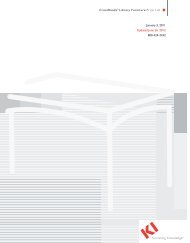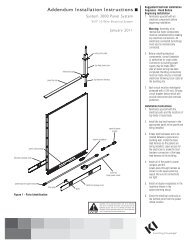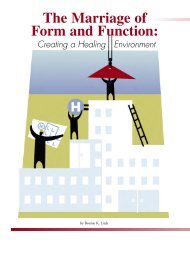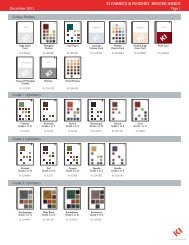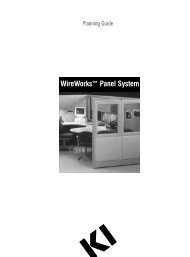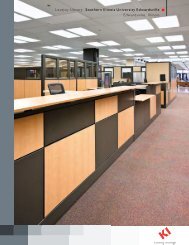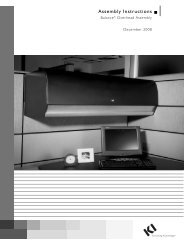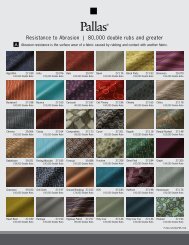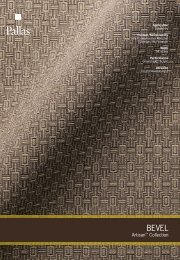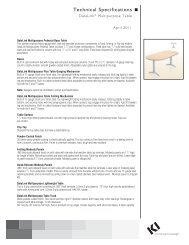Fabric Training Document_FINAL_020708.pdf - KI.com
Fabric Training Document_FINAL_020708.pdf - KI.com
Fabric Training Document_FINAL_020708.pdf - KI.com
You also want an ePaper? Increase the reach of your titles
YUMPU automatically turns print PDFs into web optimized ePapers that Google loves.
<strong>KI</strong> INGRADE FABRIC PROGRAM TRAININGFABRIC GLOSSARYDamask – (1) Originally, a rich silk fabric of woven floral designs made in China and introduced intoEurope through Damascus, from which it derived its name. (2) A construction that produces a reversiblefabric in which areas of high and low luster (satin and sateen) are contrasted to create the figure andground. (3) <strong>Fabric</strong> that features the lustrous satin surface; symmetrical layout; and vase, leaf, and plantmotifs that are typical of traditional damask-woven goods. Usually woven in damask construction but maybe printed or otherwise produced to achieve the effect. Also called framed damasks.Dobby – (1) An attachment to a loom used to facilitate the weaving of small geometric patterns. (2) Thefabrics produced on a dobby loom. (3) <strong>Fabric</strong>s featuring a small all-over geometric pattern.<strong>Fabric</strong> – A more inclusive term than cloth for textiles, plastic films, rugs and carpets, wire mesh and othersimilar materials.Flannel – A light- to medium-weight plain or twill woven that is fulled and usually napped, resulting in afabric with a soft, brushed hand.Geometric Pattern – Any pattern that features straight lines, sharp angles and geometric shapes asmotifs.Hand (Dry Hand) – The way a fabric feels when handled; In England and in older usage, “handle” is usedinstead of “hand” for this term. “Dry” is used to describe fabrics that are less smooth, or have a “toothy”texture. If the hand is “too dry” it would mean unpleasantly rough, but dry is not a negative – a wooltweed or a nubby silk would be a dry texture, <strong>com</strong>pared to a silk satin or wool suiting.Hue – The place a color holds along the color spectrum, i.e. its color name.Jacquard – A mechanism for a loom (also the fabric it produces) invented by Joseph J. M. Jacquard in1801-1804. The Jacquard machine, positioned above the loom, held a set of punched cards that instructedthe loom by means of punched holes corresponding to threads to be lifted in order to create the wovenpattern. Such mechanisms are now usually electronic rather than mechanical. Complicated patterns can bewoven efficiently by jacquard weaving and so fabrics with any non-small-scale pattern are “jacquardwoven.”Luster – The sheen of a fabric or yarn, i.e. the soft glow of its slightly reflective surface.Matelassé – A double cloth with a quilted or padded texture resulting from stuffer yarns inserted betweenlayers; usually jacquard woven in solid or near-solid colors.Mesh – A fabric that has regular openings between the yarns. It may be constructed in any appropriatemethod – knit, woven, nonwoven.Nano-Tex – A leading fabric innovation <strong>com</strong>pany providing nanotechnology-based textile enhancementsto the apparel, <strong>com</strong>mercial and residential interiors markets.Nanotechnology – The technical process of working on the nano-scale – each nano-scale molecule is onemillion times smaller than a grain of sand. Nanotechnology refers to not only the small size of the materialsbeing used, but also how those materials are engineered to perform specific functions.Traditional coatings make garments feel stiff and clog the weave of the fabric preventing breathability.Using nanotechnology, treatments are small enough to attach to individual fibers, delivering superiorperformance characteristics without <strong>com</strong>promising the look, feel or <strong>com</strong>fort of the fabric.Page 18 of 20





